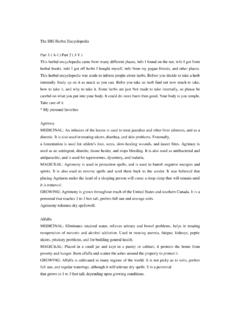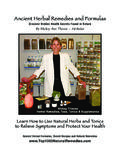Transcription of Natural alternatives to HRT - …
1 ( ) ( )Your doctor will often want to prescribe what is commonly known as HRT for any appearing hormonal imbalance. But after being flooded with endless pages of drug information listing all of their pros and cons, often we simply want to decrease the confusion and have a Natural alternative to help us on our way. Thankfully, there are some available. There are many dietary and lifestyle changes, as well as an abundance of herbs and nutrients that can be safely taken, to ease your hormonal transition. A Natural approach to HRT incorporates a balanced view to diet and lifestyle, combined with nutritional and herbal supplements. Natural therapies may be an effective option for many women wanting to avoid the possible side effects and risks associated with conventional treatments for common hormonal symptoms.
2 LIFESTYLE MODIFICATIONS Exercise: Regular exercise may help decrease the incidence and intensity of hot flushes; improve depressive symptoms, memory, sleep quality and sexual desire; manage weight; and improve lipid profile in postmenopausal women. Additionally, exercise helps stabilise and increase bone mineral density, which aids in the prevention of osteoporosis, as well as reducing the risk of cardiovascular : Stopping smoking may assist with a reduction in symptoms of menopause as smoking affects oestrogen metabolism. Women who do not smoke cigarettes generally experience fewer hot flushes than those who do. Eat More:t Plant-based foods, especially fresh fruits and vegetables such as cabbage family vegetables broccoli, cabbage, brussel sprouts, cauliflower, bok choy, Chinese broccoli, broccolini, Garlic and onion.
3 All of these are high in fibre, but also contain added nutrients to ease hormonal High fibre foods psyllium, whole grains, brown rice, root vegetables, (turnip, parsnip, carrot, sweet potato)t Bitter foods rocket, endive, kale, balsamic vinegart Sprouts alfalfa, snow peas, watercress, mung bean sproutst Foods that are unrefined, unprocessed and low in salt, fat, sugar, preservatives and additives (not in packets)t Good fats Omega 3, mono unsaturated oils. t Seeds - linseeds, sunflower, almonds (LSA), pumpkin. Freshly ground, tahinit Fish, seafood 2- 4 serves per weekt Organic meat and eggs that are free from hormone residues. Protein in minimum of 2 meals each day (fish, beans, legumes, lean meat, egg)t Drink filtered water free from chlorine, fluoride and heavy metals t Drink more - Water 1-2 litres a day; herbal teas - chamomile, peppermint, sage t Add Probiotics to your diet which aide elimination of estrogenst Whole grains (as increasing fibre allows increased binding and elimination of excess oestrogens)t Beans and legumes lentils, chickpeas, broad, red kidney, borlotti t Eat a diet rich in phytoestrogens Phytoestrogens are plant substances that have a structure similar to oestrogen.
4 They are important as they enable the binding to an oestrogen receptor site producing weak oestrogenic effects. Phytoestrogens consist of 3 main classes, namely isoflavones, lignans and coumestans; with isoflavones being the most widely studied. Phytoestrogens can easily be incorporated into the daily diet, as many food sources contain phytoestrogens: A review of studies suggests 10-15 grams of soy protein or 30-50mg of isoflavones per day may constitute an appropriate are predominantly found in soybeans and soy products as well as red clover and legumes such as lentils, kidney beans and chickpeasLignans are found in whole grains (wheat, barley, and rice), fruits, vegetables and seeds such as linseeds (flaxseeds)Coumestans are best sourced from sprouted seeds such as alfalfa and soy bean AND MINERALS The B vitamins, especially folate, B6 and B12 are essential for stress management, as well as to prevent the elevation of Homocysteine.
5 Elevated levels of Homocysteine are often seen in menopausal women, and as they are associated with an increased risk for cardiovascular disease, it may be appropriate to ensure optimal intake of these nutrients either through diet or E: Although clinical evidence is varied, an average dose of 800IU per day of vitamin E (mixed tocopherols) may be considered for the relief of hot flushes. Topical vitamin E may assist other symptoms of menopause such as vaginal dryness and atrophic vaginitis. Additionally, vitamin E inhibits the oxidation of LDL-cholesterol and has also been shown to reduce palpitations and dizziness. For vaginal dryness and irritation; try applying Vit E oil capsules directly onto skin. Calendula oil with Micelle A and E in a Vit E base is also and vitamin D: Adequate intake of calcium (1200-1500mg per day) and vitamin D combined with regular weight bearing exercise plays an important role in the prevention of osteoporosis in postmenopausal women.
6 Foods rich in calcium include dairy products, canned salmon and sardines with crushed bones, calcium fortified soy products, almonds, figs and dark green leafy vegetables. Vitamin D aids the absorption of calcium and is made in the body with exposure to sunlight. Food sources include dairy products, fish, sunflower seeds and eggs. Blood vitamin D3 is an accurate way to ensure your level is adequate. Levels should be 100, and supplementation other than foods, is often required. HERBAL MEDICINES Herbal medicines have been used for centuries to ease hormonal concerns. As herbal dose and prescription can vary, seeking a trained herbalist or naturopath is a much safer and effective way to learn which herbs are specifically indicated for racemosa (Black cohosh): This herb probably has the most scientific research behind its use in the management of menopausal symptoms such as hot flushes and sweating, sleep disturbances and nervous irritability.
7 Salvia officinalis (Sage): Traditionally sage has been used to help in the management of excessive sweating. Consequently it is often prescribed for hot flushes and night sweats. (An easy way to take sage is to pick 6 fresh leaves, soak in lemon juice overnight and drink the juice each am). Sage capsules and teas are also commercially perforatum (St John s wort): was traditionally used for nervous afflictions including psychological symptoms of menopause. The herb has shown significant improvement in improving symptoms such as lowered mood, loss of interest, sleep disturbance and sinensis (Dong quai): is a traditional Chinese medicine herb generally used in combination with other herbs for menopausal symptoms such as tiredness and hot flushes.
8 It is a uterine and reproductive tonic that rehabilitates and restores tone to the uterus. It assists with painful, irregular and scanty menstruation, especially where symptoms are associated with cramping, neuromuscular tension, debility, weakness and or anaemia. Shatavari / Wild asparagus Shatavari is considered to be an important herb in Ayurvedic medicine due to its balancing and rejuvenating properties. It is a nourishing tonic, very good for conditions of wasting, infertility, low libido and menopausal symptoms. [in good health .] Natural alternatives toHRTAt different times of our lives we need extra support to keep us feeling good. From an extra glass of water to hydrate, another serving of greens to keep us regular, or an extra sleep -in on the weekend to top up those many hours lost after a busy week.
9 What choices are we making when it comes to our hormonal health? Integrative Medicine Practitioner, Lisa Bennett, guides us through the sea of management: stress!" cortisol. Managing stress has shown to have a multitude of benefits in hormone management. Methods such as relaxation classes, controlled breathing techniques, meditation, yoga and massage such as reflexology, all show some efficacy with lowering the frequency of hot flushes and other symptoms associated with Less:t Processed and animal foodst Caffeine and spicy foods (may help reduce hot flushes in some women)t Chocolate, sugar, alcohol, soft drink, salt and protein (may affect calcium absorption) All dairy products; common disruptors of hormonest Never have canola oil.
10 NEVER!t Avoid the use of soft plastic containers (especially in microwave), plastic wrap, pesticides in food (preferably organic or biodynamic)t Polystyrene cupst Processed foods high in sugar and fat, cakes, biscuits, sweets and chocolatet Grain fed meats, opt for grass fed meatst Reduce alcohol 40







